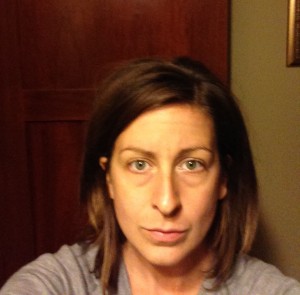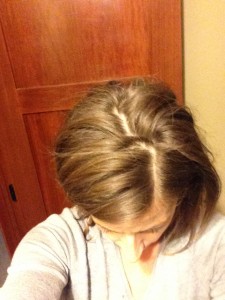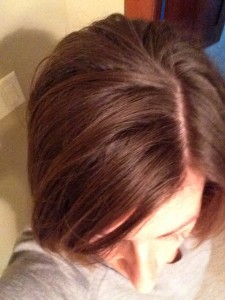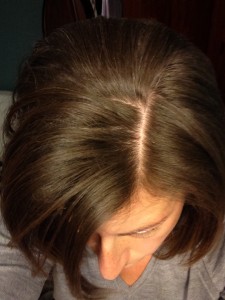What if I told you you don’t have to wash your hair? By the end of this article, you’ll believe me. You know, sometimes when you think about things, like really think about them, they start to make no sense. Well, about a year or two ago, I started really thinking about the current norm for hair care routines.
Let’s take a trip back in time.
- 200,000 years ago (198,000 B.C.) modern humans appear.¹
- 4,800 years ago (2,800 B.C.) ancient Babylonians began saponifying fats with alkali to make soap.² This soap was used for cleaning textiles, not for bathing.
- 3,550 years ago (1,550 B.C.) ancient Egyptians were bathing regularly with this manufactured soap.²
- 1,900 years ago (100 A.D.) Romans began using soap as a cleanser.²
- 200 years ago (1800’s) soap became widely available and popular in Europe.²
- 85 years ago (1930) shampoo in its modern form with synthetic surfactants was invented.³
In the last few thousand years, humans have been using plant-based saponins to wash their hair. It should be noted that saponins, such as those from the yucca root, are different than manufactured soaps and synthetic detergents. They gently cleanse without stripping away oil. But even so, look back at the second bullet point. When soap was invented in Babylon, they only used it on textiles, which indicates that they either didn’t use anything other than water to wash themselves, or that they didn’t feel the need to replace whatever substance they were using to wash themselves. I would place a hefty bet on the first option. Indeed, humans are different than other animals, but not that different to indicate that our skin and hair need to be cleaned with a special substance, whereas no other creature (besides domesticated ones) exhibit that need.
So this brings up a couple questions. The first question: why did we start washing our hair with saponins in the first place? I don’t know this answer, but I would bet it has something to do with the sociocultural shift that occurred with the appearance of agriculture, the domestication of our species, around 12,000 years ago. We started concentrating less on simply surviving, and more on things for which we simply didn’t have time as hunter-gatherers. The second question: what did humans do during that 190,000 or so years before we started washing with saponins? Now that we’ve thought this far, you can probably gather the rest. They probably bathed in water. Now remember, this was their drinking water, their only source of fresh water. They weren’t about to contaminate it with substances that shouldn’t be in the water.
Why does this matter now? Because we still don’t need to use anything to wash our hair. We don’t. I can prove it. My youngest son is two. He has thin, dark hair. I’ve washed his hair no more than five times in his life and only because he had gotten into something stinky or sticky. His hair has never looked or felt greasy, it always smells wonderful, and it’s shiny and manageable. My older son has thicker blonde hair. He hasn’t washed his hair in a month and has had the same results as his brother. I haven’t washed my hair in at least a month either, and I’ll show you pictures. I’ve had different results than the boys, and I suspect it’s because I’ve been washing my hair with shampoo or soap for 31 years. My hair smells normal and looks good, but it does have a different feel. I’ll get to that later.
This is me right after styling my hair. I had just rinsed it with water. I don’t usually style it, but you guys are special, so you get straight hair. I have wavy hair, and normally I let it air dry. If I need to look fancy, I’ll throw in a few curls with the curling iron so that it looks purposefully styled. Letting your hair do what it wants to do is best for this method. Your sebum is built to match your hair follicles, and thus your hair type.
On the topic of sebum, here’s how it goes down. My hair is not a giant pile of grease, because I have been weaning my hair off shampoo/soap for a long time. Before I switched to this step, I was washing it maybe twice a week, and I was using Dr. Bronners for cleansing and vinegar water for rinsing. My scalp had already slowed down its oil production (which is triggered by washing and stripping away the oils), and it wasn’t covered in a chemical storm from today’s shampoos. It’s not greasy, but it does have a waxy feel to it, kind of like it has a pomade in it. Overcoming this new sensation has many benefits.
Our bodies produce sebum for a reason. It is not our duty to overcome our bodily processes that have evolved over hundreds of thousands of years. Sebum protects the hair by waterproofing and lubricating it. Every time you wash away that sebum, you then have to replace all of its duties with more products. You have to condition it to add moisture back; you have to add styling products to add texture, body, and holding power; you have to take special precautions to avoid damaging your exposed strands. And if that wasn’t enough, remember how I said waterproofing? And remember how I said I have wavy hair? Check out this picture from later in the day after a shopping excursion into the misty weather. I took this picture directly after arriving home without brushing or fixing my hair.
My hair is obviously windswept but there is no frizz. It hadn’t even started to get wavy. I was out in mist for probably 6 minutes total. Not a long time, but long enough to turn a straight style into a disaster. That is, if you shampoo.
So what’s the catch, right? If this method is so great, why doesn’t everyone do it? Well, then the cosmetic industry wouldn’t get as much money, for one thing. We’re so programmed to think we need to do it, we don’t even question it. But there are some things you need to do. First, you need to get a boar bristle brush or wooden comb or brush. You need natural materials to help pull the sebum from your roots down to your tips. You need to massage (called scritching) your scalp every day. Your body is constantly shedding and renewing skin cells, and your scalp is no exception. But your hair acts to keep the cells on your scalp instead of falling to the ground, so it can start to look like dandruff. And you do still need to rinse it with water to keep it clean. The whole method is called “water only hair washing.” Here is the blog I turned to in the start of my journey. I don’t use all of her suggestions, of course; we all need to tailor routines to our own needs.
One thing she doesn’t mention in her instructions is the piecey look your hair gets. If you’re looking for piecey, your all set! But if you’re not, there is an easy fix — backcombing. Here is a picture of my hair before backcombing and after.
To round up this post, I’ll just summarize the reasons to start doing this.
- There is no actual need to wash your hair with shampoo, soap, baking soda, or plant saponins on a regular basis.
- Washing away the sebum causes problems that need to be fixed.
- No longer using shampoo, conditioner, oils, and styling products means:
- You save tons of money,
- You reduce your plastic consumption,
- You reduce the amount of toxic chemicals entering the environment (unless you’re using all-natural products),
- You reduce the amount of toxic chemicals you are applying to your body (unless you’re using all-natural products), and
- You reduce the environmental impact of the acquisition of ingredients and materials and the manufacturing of the product.
- Sebum acts as a natural frizz-guard.
- You save time by:
- Washing your hair less often,
- Therefore styling your hair less often,
- Not wasting time trying to manipulate limp hair, and
- Not having to shop for products on a regular basis.
- You’ll be just that much more self-reliant and resilient.
I am thus hereby proclaiming the water only hair washing method the new cool thing to do. Make no mistake — this is no fad. Once you get used to that extra cash, time, and awesomeness, you too will be laughing at the endless aisles of useless hair care products.
![IMG_6397[1]](https://veronicashukla.com/wp-content/uploads/2015/11/IMG_63971-e1447735220788-768x1024.jpg)



